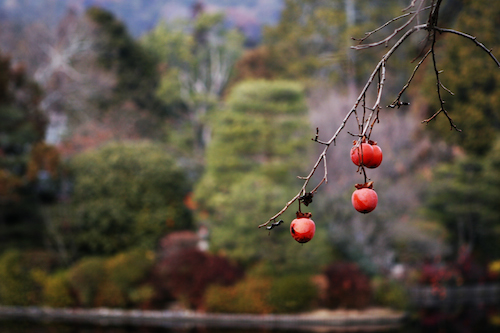Persimmons: The (other) food of the Gods.
Abundant, gorgeous, and just a little perplexing, persimmons are emblematic of a Sonoma County state of mind. No school here claims persimmons as their team mascot, but it would not be a stretch.
Persimmons offer ease of cultivation, culinary possibility, and ornamental beauty. Finding persimmons is easy enough: if not your farmers’ market, look to your neighbor, your cousin, your co-worker, or anyone whose yard boasts a persimmon tree. They’re eager to share; trust me. Even a devout grower of persimmons finds themselves swimming in the glossy-skinned things this time of year.
Using persimmons is another matter. Happy seasonal sights in Sonoma County, they are still not a default member of our nation’s oranges-apples-bananas fruit lexicon. You have to be intentional with persimmons, you must engage with them. Boasting a harvest period from the end of September to the beginning of December, persimmons can cover all of your fall fruit cravings. Best of all, they find their soul mates with cinnamon, ginger, clove, and other spices evocative of autumn.
Persimmons are native to Asia—unless they’re not. Diospyros virginiana, native American persimmons that can be found growing wild and cultivated, produce fruit that’s the size of bloated acorns. A Midwestern delight, they don’t grow west of Kansas.
Persimmons of Asian descent find their ideal habitat in Northern California. Fuyus and Hachiyas, the two dominant cultivars of Diospyros kaki that thrive in California, are far more accessible and way less seedy then their New World cousins. A little Latin: dios means god; pyros, grain or food. So there’s your food of the gods, possibly growing outside your window right now. “The Fuyu is an acceptable gift to Buddha,” assures the California Fuyu Grower’s Association. Diospyros kaki don’t need winter frost, love hot summers, and bloom later in the season. Perfect for commercial crops! They don’t need a lot of space to grow and don’t require cross-pollination, so a single tree will bear fruit. Perfect for planting at home! Add to this that persimmons are fairly drought-resistant. You may curse the lack of rainfall, but—for this year, at least—it will still rain persimmons.
In 1870, the USDA imported grafted trees and distributed them to California, among other states. Between California’s persimmon-friendly climate and its population of Asian immigrants, the fruit took hold.
If you have licked felt lately, you can identify with the chalky-cheek sensation of biting into an unripe persimmon. They’re packed with astringent tannins. Get persimmons while they are still firm and they’ll grace your counters as they do their thing and ripen into non-astringent, honeyed sweetness. (To speed up ripening, put persimmons in a paper bag with an apple; the ethylene emitted by the apple will soften them up.)
Squat and round Fuyus are more user-friendly in that they are sliceable when ripe. Technically, you could eat one like an apple, but most folks cut them into chunks. Wrap a slice of Fuyu persimmon with prosciutto for classy pre-holiday meal nibble. Fuyus are the more salad-friendly persimmon, too. Combine them with bitter greens, toasted nuts, and dried fruits or pomegranate seeds in a simple vinaigrette for a harvest-themed salad.
If you have licked felt lately, you can identify with the chalky-cheek sensation of biting into an unripe persimmon.
Bigger, tapered Hachiyas are soft when ripe. Score their skin and inside you’ll find a gelatinous pulp the color of salmon roe. Switch up the spicing a little and you can use Hachiya pulp in any baking recipe as you would mushed-up ripe bananas. The easiest way to preserve Hachiya persimmons is to freeze the pulp in Ziplock bags. You can even freeze an entire ripe fruit, let it thaw a bit, and enjoy the pulp with a grapefruit spoon as a whole-foods take on sorbet.
But there are other, more romantic ways, to enjoy them. Hoshigaki, Japanese dried Hachiya persimmons, are an increasingly rare delicacy that commands up to $35 per pound. A faint, powdery bloom of naturally occurring fructose coats their exteriors, and they are eaten as-is for a chewy, flavor-packed treat. Unlike most Hachiya preparations, hoshigaki use still-firm persimmons. As they dry over several weeks, one must massage their flesh every day to break down the cell walls of the fruit. It’s a labor of love, but if you face a bushel of homegrown Hachiyas that you can’t bear to waste, it’s a lovely end for them to meet. An alternative: fruit leather. Fire up your dehydrators, kiddos. (Persimmons, by the way, pack up to twice as much fiber as apples, if fiber is your main reason for eating fruit.)
Since the average cookbook isn’t exactly bursting with enticing recipes for this plentiful niche fruit, the food galaxy of the blogosphere is a great place to mine ideas to escape from the pudding-muffin-Bundt rut—especially homesteading-minded sites, which gleefully pack persimmon chutneys, butters, and jams into pretty jars. Much more my speed: persimmon salsa made with diced Fuyus and habañeros. I also love the homey, custardy delight of persimmon pudding, which would hammer pumpkin pie in a fall dessert throw-down any day.
In the thick of these persimmon-glut weeks, it’s easy to forget that, in coast-to-coast terms, persimmons are uncommon and exotic. Rare. And, because of that, desirable. Without even eating a persimmon, our nearness to them makes us part of something distinctive. Persimmons, it can be lovingly argued, are an indelible part of our sense of place.
Article Resources:
Find local persimmons at farmtrails.org

